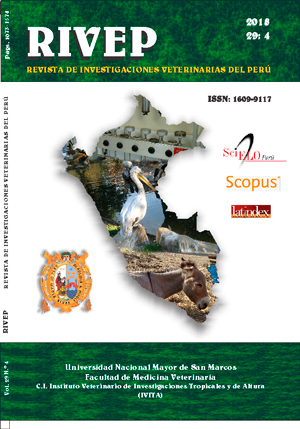Relationship between two methods of heat detection and reproductive efficiency in Holstein cows
DOI:
https://doi.org/10.15381/rivep.v29i4.15388Keywords:
oestrus, cows, heat detection, activity meterAbstract
The objective of the study was to evaluate two methods of detection of oestrus in two seasons and their influence on reproductive efficiency in Holstein cows. A total of 1445 records was evaluated from an intensive commercial farm located in the north of Lima, Peru in 2014. The methods of detection of oestrus were a commercial activity meter (T1), visual observation (T2) and the combination of both methods (T3). The reproductive parameters evaluated were the rate of heat detection, conception rate, number of services per conception, open days and parity number. The highest number of heats was detectedwith T3 (52.2%) compared to 27.5% of T1 and 20.2% of T2 (p<0.05). T1 was more efficient in detecting heats during the summer (34.7% heats) compared to T2 (13.2%) (p<0.05). T1 showed a higher number of heats in the first and second lactations (30.3 and 26.5%, respectively) compared to T2 (20.0 and 19.7%, respectively) (p<0.05). There was no significant difference between treatments in relation to conception rate and number of services per conception; however, a lower number of open days in services made in heats detected by visual observation (117 days) were found compared to those by the activity meter (144 days). It is concluded that the activity meter is more efficient than the visual observation in the detection of heats; however, the best results are obtained by combining both methods.
Downloads
Downloads
Published
Issue
Section
License
Copyright (c) 2018 Yaneline Hidalgo V., Carlomagno Velásquez V., Néstor Chagray A., Nidia Llapapasca G., Alfredo Delgado C.

This work is licensed under a Creative Commons Attribution-NonCommercial-ShareAlike 4.0 International License.
AUTHORS RETAIN THEIR RIGHTS:
a. Authors retain their trade mark rights and patent, and also on any process or procedure described in the article.
b. Authors retain their right to share, copy, distribute, perform and publicly communicate their article (eg, to place their article in an institutional repository or publish it in a book), with an acknowledgment of its initial publication in the Revista de Investigaciones Veterinarias del Perú (RIVEP).
c. Authors retain theirs right to make a subsequent publication of their work, to use the article or any part thereof (eg a compilation of his papers, lecture notes, thesis, or a book), always indicating the source of publication (the originator of the work, journal, volume, number and date).










